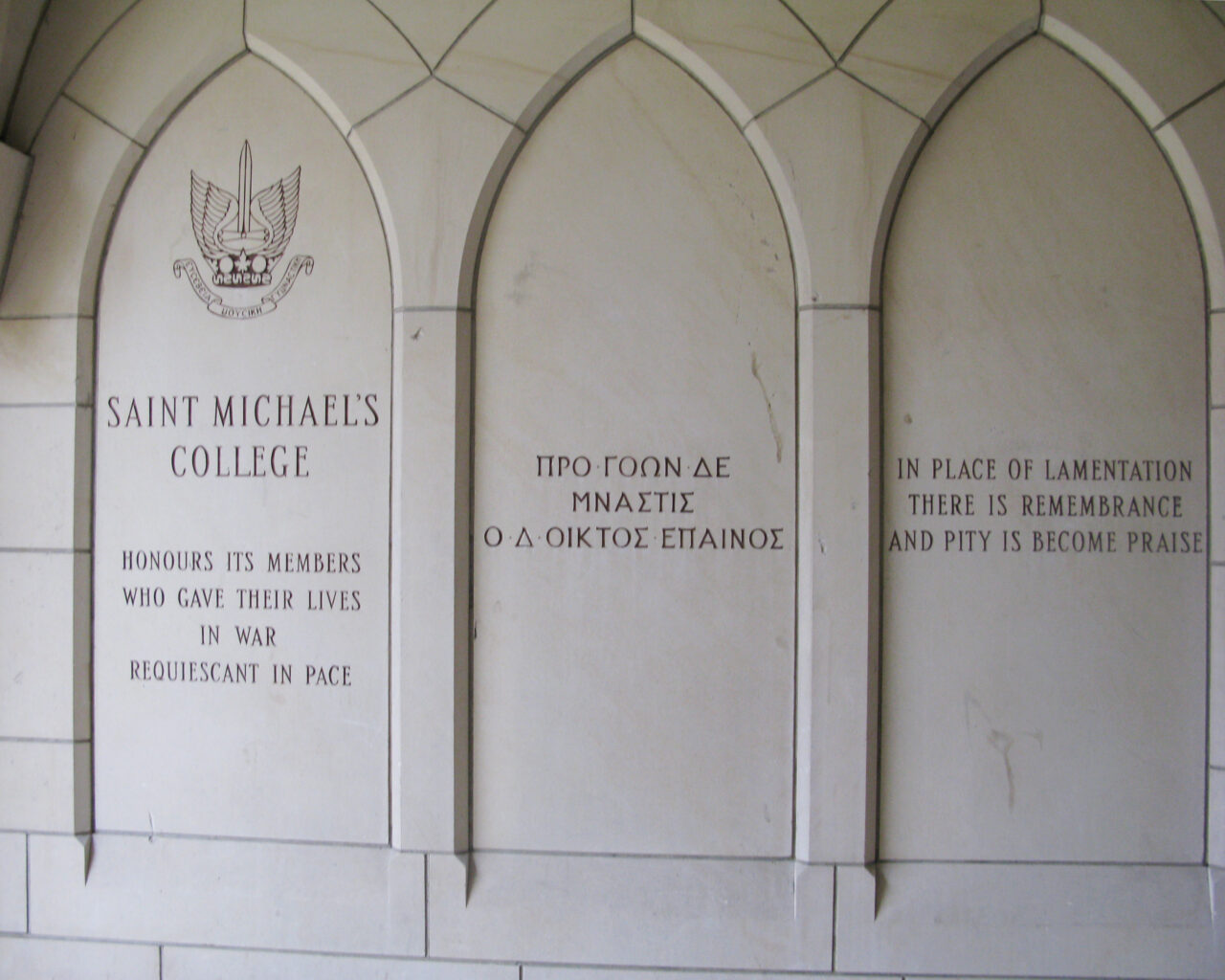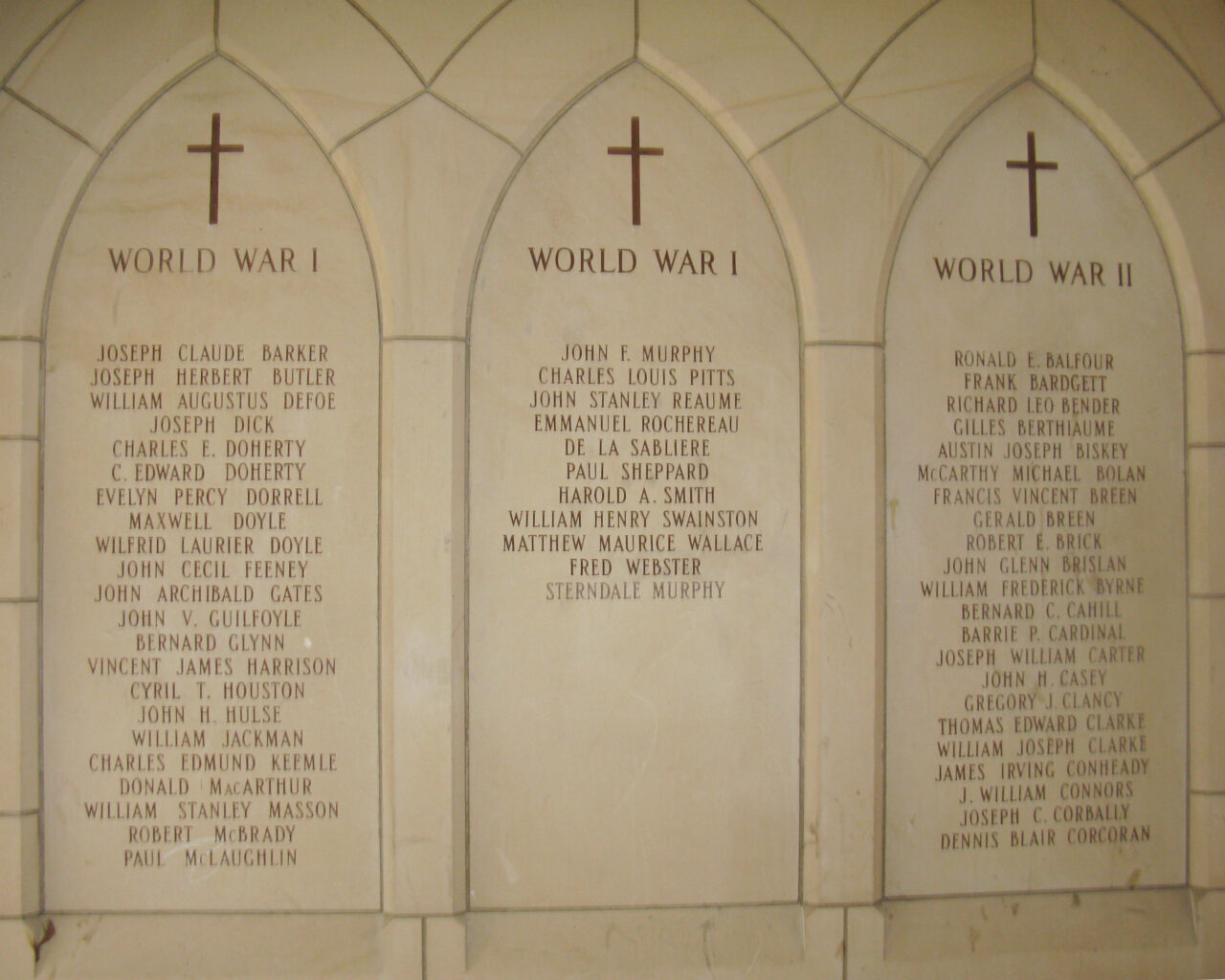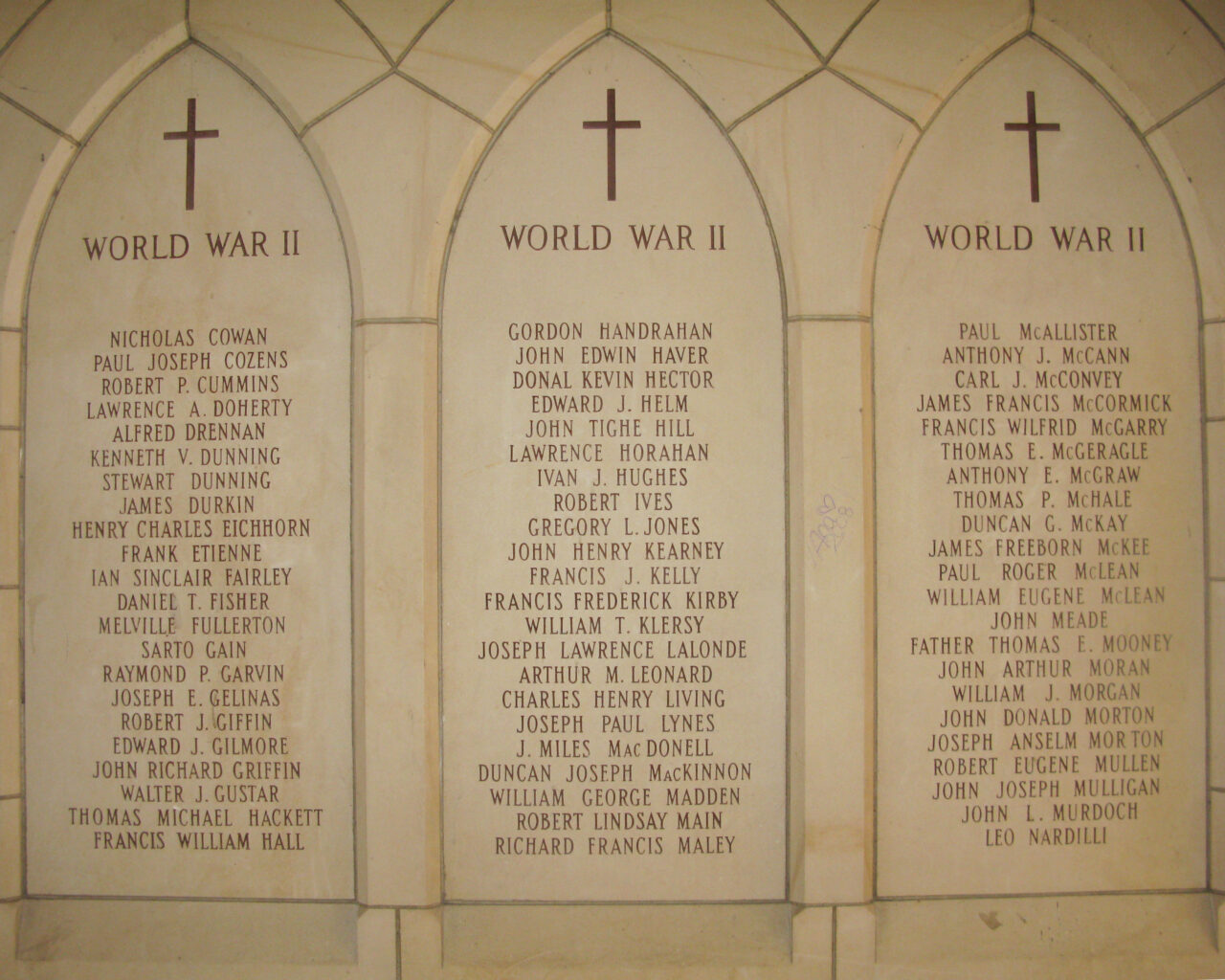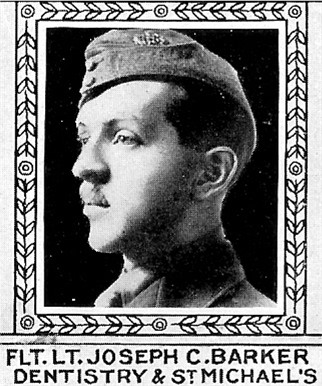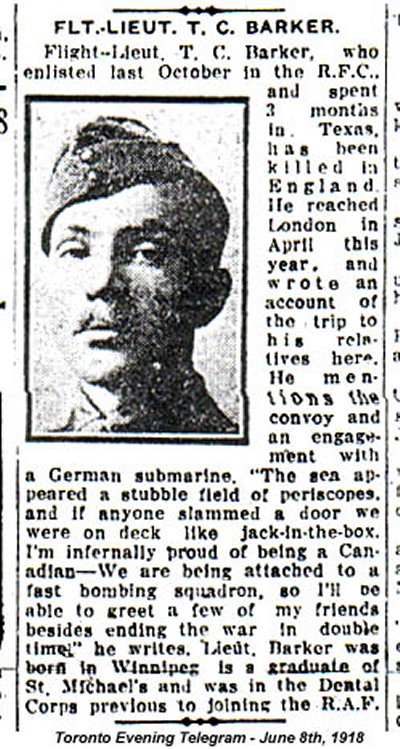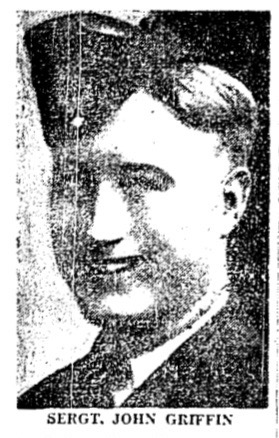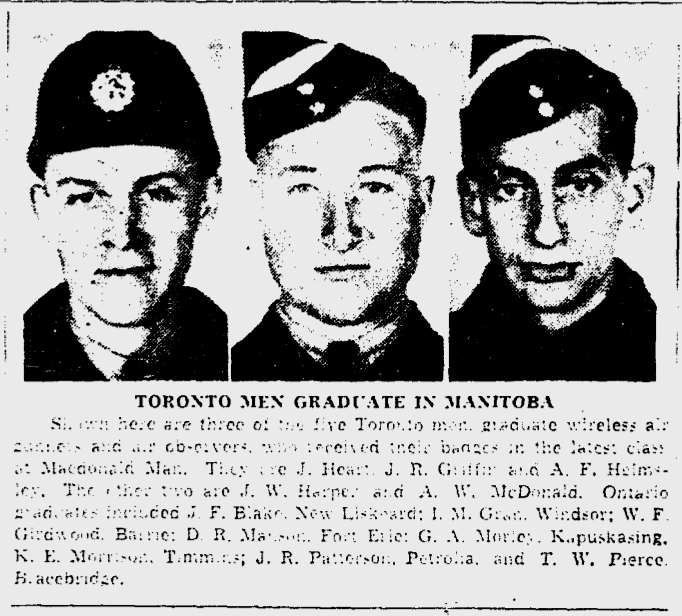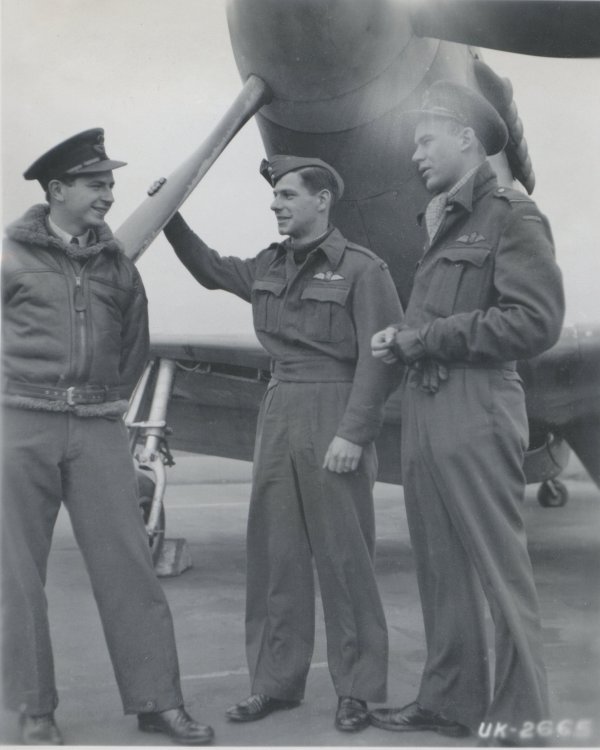The following was written by University of St. Michael’s College Interim Principal Mark McGowan as part of his weekly message to his staff.
Each Name was a Life
This missive comes a few days earlier than usual… Normally I would not disturb you during Reading Week, but Remembrance Day is this week, and I could not let it pass without some thoughts about the College and the students and alumni who lost their lives in the major wars of the 20th century. Each year I try to attend our ceremonies of remembrance at the Slype, the walkway between More and Fisher Houses, which is where the names of those who “fell” are inscribed. I regret that I am unable to be on campus tomorrow but would like to leave you with a few thoughts about the “last names.”
The last name on the list of young men commemorated for their service in World War I is Fred Webster. Early in my teaching career at SMC, I had a mature student in my history of Christianity class who offered me a story about his mother’s favourite uncle, this same Fred Webster, who coincidentally was part of a much larger research project in which I was engaged. Fred was a student at St. Michael’s College who suffered from a debilitating heart condition. When he tried to enlist locally in the Canadian Expeditionary Force, he was refused on medical grounds. He tried many times to join his classmates overseas, but every time the refrain from recruiters was the same: rejection. On the streets of Toronto, Fred was berated by passersby as a young man who was a shirker, not doing his bit for “King and Country.” They had no idea of the story of his repeated attempts to enlist and his repeated rejections. In January 1918, however, when the Allies were desperate for reinforcements in a war that was not going very well, Fred was accepted and was sent to the military training camp near the Toronto Exhibition grounds. As a well-educated recruit who worked in banking, Fred was promoted to Acting Sergeant in March. During the mandatory swim near Hanlan’s Point, however, Fred had a massive heart attack and drowned. At age 24, his war ended in Canada.
When I arrived at St. Michael’s in 1991, I attended my first Remembrance Day ceremony at the Slype. Among the group of students and Faculty I noticed a woman standing at attention close to the opening of the Memorial. She remained for some time after the ceremony had ended. In the months to come I saw her from a distance, from time to time, in Alumni Hall. The following year, on November 11, she was at the Slype again. I asked my colleague, Mimi Marrocco, who this older lady was, standing at a distance from the group. Mimi told me her name was Sister Mary Zimmerman, CSJ. She had been the Executive Director of St. Michael’s Hospital (1963–85) and was currently assisting Father Bob Madden in Alumni Affairs. Then Mimi added that she came here every year to remember her husband, Maurice Dier Zimmerman, the last name on the World War II list. An alumna of SMC, Bernice Veronica Lannan (Sr. Mary) met Maurice at St. Basil’s Parish, where she was actively engaged in parish activities. They were married in 1943 at St. Basil’s, just before Maurice shipped out with the RCAF. He never returned; his squadron was stationed in the Middle East, and he was declared missing, later killed in action, when his plane crashed during a raid over Greece in July 1944. Four years later, after having worked in the pharmacy at St. Michael’s Hospital, the widowed Bernice (Sr. Mary) decided to join the Sisters of St. Joseph where she had a distinguished career, including an associate professorship in U of T’s Faculty of Medicine. She insisted on keeping her married name in religious life. Each year she ventured to the Slype to honour her Maurice. She died in 1994, faithful to a love that never ceased.
Every time I pass through the Slype, I remind myself: Each name was a life. Each life was a story. Lest we forget.
Read other InsightOut posts.
Remembering St. Mike’s Fallen
“They shall grow not old, as we that are left grow old,” poet Laurence Binyon wrote in his 1914 classic work, For the Fallen, of those who lost their lives in battle.
More than 150 St. Michael’s men—students and graduates—who died in World War I, World War II, and the Korean War are remembered on the Soldiers’ Memorial Slype, the sandstone archway found between Fisher House and More House. On November 11, 2021 at 10:30 a.m. we will gather there for our Remembrance Day ceremony, recalling our fallen students and all who have lost their lives in battle.
Here are the stories of two St. Michael’s fallen.
Second Lieutenant Joseph Claude Anthony Barker was born in Toronto on March 3, 1895 and attended St. Michael’s in 1912–1913, then enrolled in the College of Dental Surgeons. Through the summer of 1916 he served as a sergeant in the Canadian Army Dental Corps at Camp Hughes, and then returned to college to complete his course. He again served in the C.A.D.C. in Winnipeg and Camp St. Charles in the summer of 1917. In October he joined the Royal Flying Corps at Toronto and trained through the winter in Texas, obtaining his commission in March 1918. After reaching England he was completing his course when he was accidentally killed in a flight near Bournemouth, the day before he was due to go to France. He is buried at Durrington, England.
“I’m infernally proud of being a Canadian,” he wrote in a letter to his family in 1918.
Flight Sergeant John Richard Griffin, the son of John Joseph and Bridget Griffin, was born in Toronto in 1918 and attended St. Michael’s in 1935–1936. He earned his wings with the Royal Canadian Air Force in October 1941 and was sent overseas in November of that year to serve with Division 7 (R.A.F,) Squadron. He died on July 13, 1942 of injuries sustained in combat and is buried in Buxton Cemetery in Derbyshire, England.
“Age shall not weary them, nor the years condemn.
At the going down of the sun and in the morning
We will remember them.”
Laurence Binyon, 1914
Read other InsightOut posts.
Voices Honouring St. Mike’s Fallen
The Soldiers’ Memorial Slype is one of the most moving spots on the St. Michael’s campus. The sandstone archway is found between Fisher House and More House and connects the campus quad to Queen’s Park. Unfortunately, the pandemic has forced the cancellation of on-campus events this Remembrance Day, but our fallen are not forgotten.
Etched into the walls of the spare and understated war memorial are the names of more than 150 men from the St. Michael’s College and St. Michael’s College School, students and graduates, who died in World War I, World War II, and the Korean War.
Here are two of them.
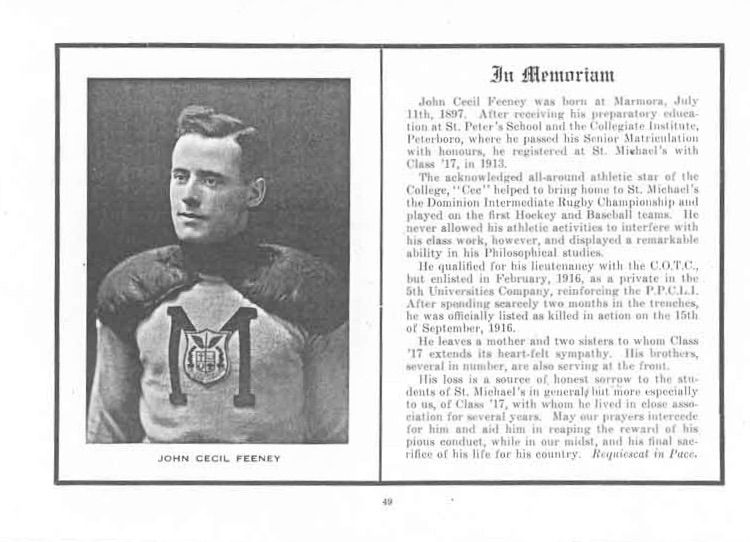
Private John Cecil Feeney was born in Marmora, On., in 1897 and enrolled at St. Michael’s in 1913 to study Philosophy. The St. Michael’s Yearbook of 1917 states that Cee, as he was known to his friends, played rugby, baseball and hockey and was “the acknowledged all-round athletic star of the College.” The yearbook also notes, though, that his love of athletics notwithstanding, Feeney was a dedicated student who “displayed a remarkable ability in his Philosophical studies.”
Although his time serving in the Canadian Officers Training Corps afforded him the rank of lieutenant, he enrolled as a private in the 5th Universities Company, which was part of the Princess Patricia’s Canadian Light Infantry, in February of 1916. In July of that year he joined his battalion in France. Two months later, on September 15, he was killed in action in the battle of Courcelette and was buried there, far from his grieving mother and two sisters, and, as the yearbook notes, “several brothers … serving at the front.” His name appears on the Vimy Memorial in Pas de Calais, France.
“His loss is a source of honest sorrow to the students of St. Michael’s in general,” his classmates wrote, “but more especially to us, the Class of ’17, with whom he lived in close association for several years. May our prayers intercede for him and aid him in reaping the reward of his pious conduct, while in our midst, and his final sacrifice of his life for his country. Requiescat in Pace.”
Feeney is also remembered in the University of Toronto Roll of Service, 1914–1918.
Flying Officer Lawrence Aloysius Doherty, the son of Thomas Arthur and Mary Doherty, was born on April 1, 1918 in Toronto. He was a member of the 414 Squadron of the Royal Canadian Air Force, enlisting in Hamilton in 1940.
While on a secret mission over the English Channel on June 6, 1943, he alerted fellow officer Rowan Hutchinson that he had spotted a trio of German planes—Folke-Wulf 1900s, according to the Canadian Virtual War Memorial—about to attack. His warning saved Flying Officer Hutchinson, but Doherty’s plane was shot down over the Bay of Biscay.
The accompanying newspaper article below quotes Hutchinson as explaining that he was flying in the lead when Doherty radioed to say, “Look out, Hutch!” prompting Hutchinson to turn just in time to see his friend’s plan crash into the water.
“Larry saved my life,” Hutchinson explained.
Doherty, with no known grave, is remembered on the Runnymede Memorial in Surrey, England.
He is also honoured in the University of Toronto Memorial Book of 1939–1945.
They shall grow not old, as we that are left grow old;
Age shall not weary them, nor the years condemn.
At the going down of the sun and in the morning
We will remember them.
“For the Fallen,” Laurence Binyon
1914
Read other InsightOut posts.


